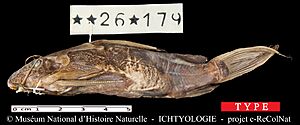Synodontis centralis facts for kids
Quick facts for kids Synodontis centralis |
|
|---|---|
 |
|
| Conservation status | |
| Scientific classification | |
| Genus: |
Synodontis
|
| Species: |
centralis
|
Synodontis centralis is a special kind of upside-down catfish. It lives only in the Democratic Republic of the Congo, in the middle part of the Congo Basin. This means it is endemic to that area. A scientist named Max Poll first described this fish in 1971. The first fish studied were found in Ndwa village, Kunungu, Zaire. The name centralis means "central," which refers to its home in the central Congo Basin.
Contents
What Does the Synodontis Centralis Look Like?
Like other Synodontis fish, S. centralis has a strong, bony head. This head bone goes all the way back to the first spine on its top fin. It also has a small, bony bump on its side called a humeral process.
Fish Features
This catfish has three pairs of barbels, which are like whiskers. One pair is on its upper jaw. The other two pairs are on its lower jaw. It has a large, fleshy fin on its back called an adipose fin. Its tail, or caudal fin, is shaped like a fork.
Spines for Safety
The front edges of its top fin and side fins are hard spines. These spines can stand straight out from its body. They can lock into place to protect the fish from danger. Small bones help the fish lock these spines. Once locked, the spines cannot be pushed down easily.
Teeth and Size
The fish has a special pad of teeth on the very front of its upper jaw. These teeth are short and shaped like chisels. On its lower jaw, the teeth are attached to flexible stalks. They are described as "s-shaped" or "hooked."
The Synodontis centralis can grow up to about 13.5 centimeters (about 5.3 inches) long. Female Synodontis fish are usually a bit bigger than males of the same age.
Synodontis Centralis Habitat and Habits
In the wild, this fish lives in the central part of the Congo River basin. People sometimes catch and eat these fish.
What They Eat
Synodontis fish are omnivores. This means they eat both plants and animals. They munch on insect larvae, algae, snails, clams, sponges, and small crustaceans. They also eat the eggs of other fish.
Reproduction and Life Cycle
Scientists do not know much about how most Synodontis fish reproduce. They have found eggs inside some female fish. It is thought that they lay their eggs during the rainy season. This usually happens between July and October. During this time, pairs of fish might swim together to lay eggs. Young fish grow very fast in their first year. After that, their growth slows down as they get older.


